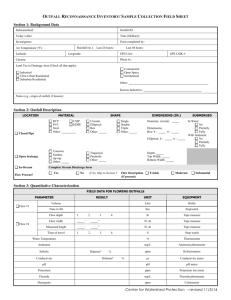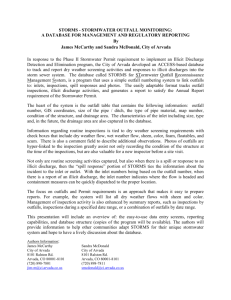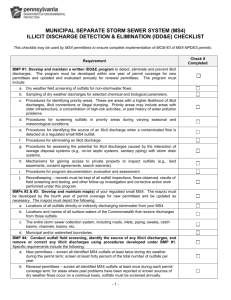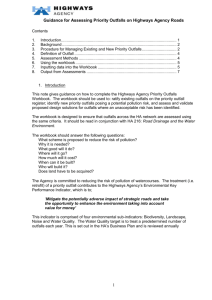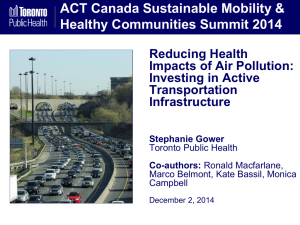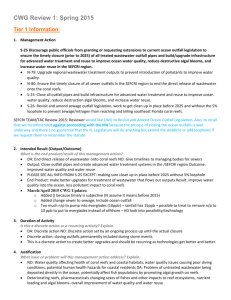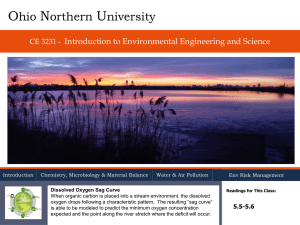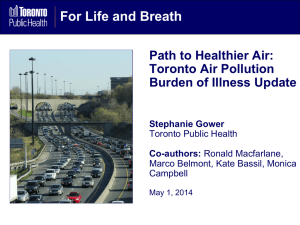outfall monitoring program
advertisement
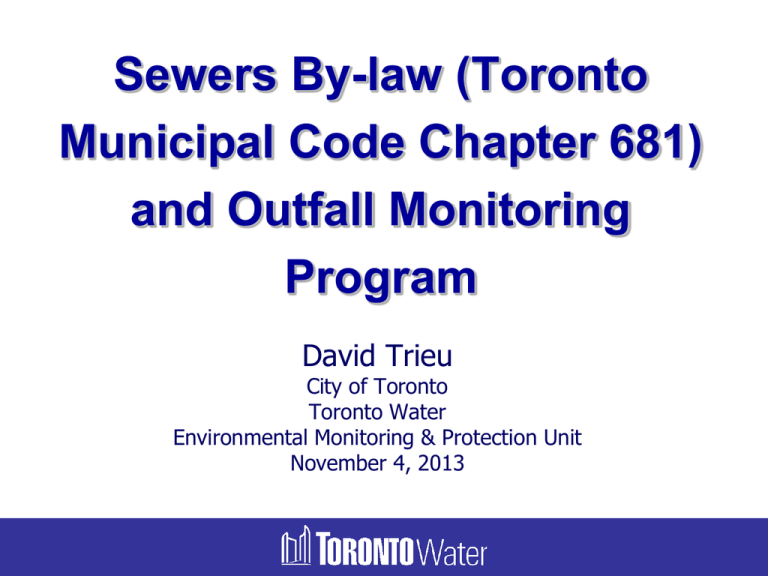
Sewers By-law (Toronto Municipal Code Chapter 681) and Outfall Monitoring Program David Trieu City of Toronto Toronto Water Environmental Monitoring & Protection Unit November 4, 2013 AGENDA 1)Who we are and primary duties 2)Industrial Waste Control Group (IWC) 3)Stormwater Quality Group (SQG) 4)Sewers By-law 6)Outfall Monitoring Program (OMP) WHO WE ARE: • • • • 51 Staff Members Management, Engineer, Support Staff & Field Officers (Provincial Offences Officers) 3 Key Sections: Industrial Waste Control Group: • Stormwater Quality Group: • 15 areas within the City 24/7 Spill & Complaint Response 6 Tributary Watersheds and Lake Ontario Backflow Prevention Group: Ensures 30,000 industries in Toronto have valid BFP devices Sewers Bylaw Compliance & Monitoring (Industrial / Commercial / Institutional) Pollution Prevention Program Enforcement (Courts) (Water Supply Bylaw) Environmental Monitoring & Protection Block 2 Industrial Water Rate Program (Compliance End) Outfall Monitoring Program Spills/Complaints 24/7 coverage Manage & Create Agreements under Sewers Bylaw Monitoring Toronto Beaches, Special Monitoring Projects Staff Reports to Committees Training All TW, TPH, Legal, PPFA -Day to Day Core Activities - Required Backflow Prevention Program Public Outreach Technical Advice (Road Salt) Transportation INDUSTRIAL WASTE CONTROL GROUP • • • • Enforce Sewers and Water Supply By-law – 15 areas within the City Monitor Industrial discharges & on-site Pollution Prevention (P2) plans Industrial Waste Surcharge & Sanitary Discharge Agreements Respond to water pollution complaints, industrial-commercial spills. STORM QUALITY GROUP • Outfall Monitoring Program • • • Monitor storm outfall discharges Beach & Lake water quality monitoring Stormwater complaint investigations Special Stormwater projects Inner Harbour Monitoring Environmental Assessment Monitoring SEWERS BY-LAW OBJECTIVES: • Reduce chemicals going to sewers, to help protect Lake Ontario & Toronto’s Rivers and streams & wastewater treatment plants • To regulate the quality of storm and sanitary discharges into City’s storm & sanitary sewers • To ensure that sewage sent to treatment plants is treatable and to continuously improve bio-solids quality • Environmental protection and long-term health of receiving waters • Comply with Federal and Provincial legislation SEWERS BY-LAW HIGHLIGHTS: • • • • • • Contains Discharge Limits and requirements for the Sanitary, Combined, and Storm Sewers Pollution Prevention Plan Requirements Waste Surcharge and Sanitary Discharge Agreements, Industry Compliance Programs Right of Entry for Officers Spill Reporting Requirements Penalties and Fines OUTFALL MONITORING PROGRAM (OMP) OBJECTIVES: • Program initiated in late 2005. • To locate and survey all outfalls within Toronto. • To sample all outfalls with a dry weather flow. • To identify contaminated stormwater flows. • Initiate remedial and or enforcement action to eliminate the sources of contamination under authority of the Sewers Bylaw. • Update city maps HOW DOES THE OMP WORK? • There are 6 key steps in this program STEP 1: SURVEYING AND SAMPLING • Outfalls are the exit points of the storm sewer system for drainage of surface runoff (ie rain, snowmelt) • Each individual watershed is surveyed for all Outfalls, defined as any pipe greater than 10 cm. • Each surveyed outfall with dry weather flow is sampled at least twice. During this phase, 2 rounds are sampled. • Sampling Parameters may include: E. coli, TSS, pH, BOD, Metals, Total Phosphorus, TKN and Phenols. • Other parameters can also be sampled and tested at the discretion of the investigating Officer STEP 2: CLASSIFICATION OF OUTFALLS • Outfalls are classified as either Priority, Concern, or Interest using sample results. STEP 3: INVESTIGATE PRIORITY OUTFALLS • Priority Outfalls are actively investigated and sampled • Pollution source tracing is done from the outfall, going upstream through the storm sewer • Strategic storm manhole points are inspected and compared to each other • Areas of higher pollutant concentration indicate proximity to the source (Narrowed down to be in between two manholes) STEP 4: POLLUTION SOURCE INSPECTIONS • Property inspections begin once the source has been narrowed down to be in between two manholes • All properties in between those two manholes are flagged for inspection and are issued dye test letters • Pollution sources can come from cross connected properties or through illegal dumping/discharge into catch basins • A cross connection is an illegal sanitary plumbing fixture connected to the storm sewer line • Other potential sources of pollution include sewer infrastructure problems • Main test methods include; non toxic dye testing the property and video testing the storm sewer lines STEP 5: ENFORCEMENT • Stepwise enforcement (cross connections properties) • Property owners are issued verbal warnings not to use the cross connected fixtures until the problem is rectified. • Property owners are issued by mail, written Notices of Violation, indicating they are in breach of the Sewers By-law. • Legal action taken and issue fines, if necessary STEP 6: DELISTING PRIORITY OUTFALLS • After Priority Outfalls are thoroughly investigated they can be delisted to Outfalls of Interest, if the water quality has improved. • This requires obtaining 3 clean samples from routine monitoring and sampling at the outfall. • A clean sample is defined as having the attributes of an Outfall of Interest. OUTFALL MONITORING PROGRAM STATISTICS Since start of the OMP in late 2005 to 2012 • 2,631 Total Outfalls Surveyed • Taylor Massey Creek (TMC), Black Creek, Rouge River, Etobicoke Creek, Humber River, Highland Creek, Mimico Creek and Lake Ontario completely surveyed. • 634 cross connections found (including infrastructure problems and multi-unit buildings) • 592 cross connections corrected (inc. infrastructure problems and multi-unit buildings) • 70 Delisted Priority Outfalls (23 in TMC) • 100 Priority Outfalls were under investigation (31 in TMC) • The year, the Don River has been surveyed and being sampled • City staff reports with further details available online to the public Thank you! Any Questions?
